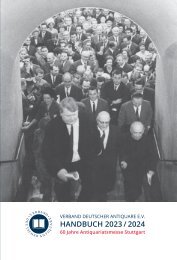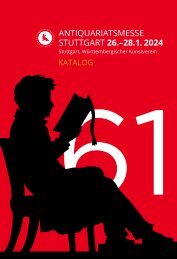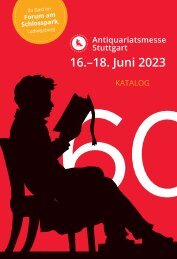Antiquariatsmesse Stuttgart 2022 - Katalog
Katalog zur Antiquariatsmesse Stuttgart 2022: Die diesjährige Antiquariatsmesse Stuttgart, Deutschlands bedeutendste Messe für schöne und seltene Bücher, Autographen, illustrierte Werke und Graphik findet, wie bereits im vergangenen Jahr pandemiebedingt nicht als klassische Messe, sondern in Form des gedruckten Kataloges und als digitale Messe auf bewährter Plattform (18. bis 22. Februar 2022) statt. 73 Antiquariate und Galerien aus Deutschland, Österreich und der Schweiz, den Niederlanden, Frankreich, England und den USA werden auch in diesem Jahr die gesamte Bandbreite des Antiquariatshandels präsentieren. Der gedruckte Katalog wird ab dem 31. Januar 2022 an interessierte Kunden verschickt, die virtuelle Messe öffnet ihre „digitalen Pforten“ am 18. Februar 2022 um 12.00 Uhr unter www.antiquariatsmesse-stuttgart.de
Katalog zur Antiquariatsmesse Stuttgart 2022: Die diesjährige Antiquariatsmesse Stuttgart, Deutschlands bedeutendste Messe für schöne und seltene Bücher, Autographen, illustrierte Werke und Graphik findet, wie bereits im vergangenen Jahr pandemiebedingt nicht als klassische Messe, sondern in Form des gedruckten Kataloges und als digitale Messe auf bewährter Plattform (18. bis 22. Februar 2022) statt.
73 Antiquariate und Galerien aus Deutschland, Österreich und der Schweiz, den Niederlanden, Frankreich, England und den USA werden auch in diesem Jahr die gesamte Bandbreite des Antiquariatshandels präsentieren.
Der gedruckte Katalog wird ab dem 31. Januar 2022 an interessierte Kunden verschickt, die virtuelle Messe öffnet ihre „digitalen Pforten“ am 18. Februar 2022 um 12.00 Uhr unter www.antiquariatsmesse-stuttgart.de
Erfolgreiche ePaper selbst erstellen
Machen Sie aus Ihren PDF Publikationen ein blätterbares Flipbook mit unserer einzigartigen Google optimierten e-Paper Software.
First edition of this translation, the issue with the engravings<br />
in black and white. The identity of the ‘English<br />
literary gentleman’ who assisted in the translation<br />
(and probably wrote the preface) remains unknown.<br />
‘It is evident that he was acquainted with the history of<br />
’Werther’ in England, and, while the title of the work<br />
places him somewhat in the background, the general<br />
character of the translation leads me to ascribe a considerable<br />
portion to the hand of an Englishman’ (Long,<br />
p. 195). – Carré, p. 30; Goedeke IV/III, 197, 11; Morgan<br />
2543; Oswald, p. 55; Speck 862.<br />
Drawing by H. Bunbury Esq r is with the greatest<br />
respect Dedicated by Her most obedient servant W.<br />
Dickinson. London, Published August 21 st 1783 by<br />
W. Dickinson. [With:] Sorrows of Werter. To day<br />
I was sitting by Charlotte; she was playing on her<br />
harpsichord with an expression it is impossible for<br />
me to discribe [sic] to you … London Pub d April, 21,<br />
1785 by Ia s Birchall. [And:] Sorrows of Werter. They<br />
had passed an hour in this irksome situation, when<br />
the arrival of Werter’s servant completed Charlotte’s<br />
distress … London Pub d April, 21, 1785 by Ia s Birchall.<br />
3 etchings with stipple (the first 400 × 360 mm,<br />
on a folio sheet, 565 × 405 mm; the others 255 × 203<br />
mm, trimmed to platemark) by Bartolozzi, the first<br />
after Bunbury, the others after Ramberg, printed<br />
in sanguine; some spotting to the Rambergs, but in<br />
very good condition. € 1400,–<br />
It is fitting that two of the prints here are after work by<br />
the artist Johann Heinrich Ramberg (1763–1840), who<br />
had come to England in 1781, where he was immediately<br />
‘introduced to George III, for whom he made<br />
many humorous sketches and caricatures. He is said to<br />
have been a pupil of Sir Joshua Reynolds and Francesco<br />
Bartolozzi, and in November 1781 he entered the Royal<br />
Academy Schools, where he studied with Benjamin<br />
West under the special protection of George III’ (Oxford<br />
DNB). – Calabi & De Vesme 1415–7; Carré, pp.<br />
21–23; see also Speck 1348 for the third print.<br />
Goethe, Johann Wolfgang von. The Sorrows of<br />
Werther; translated from the German … By Fred.<br />
Gotzberg, assisted by an English literary Gentleman<br />
… London: Printed by J. Cundee … 1802.<br />
12mo, pp. iv, 194, [6]; with a stipple-engraved frontispiece<br />
and 5 further plates by Hopwood; some<br />
light toning; contemporary calf gilt, a little rubbed,<br />
smooth spine gilt in compartments. € 350,–<br />
Goethe – Bell, Major James. Letters from Wetzlar,<br />
written in 1817, developing the authentic Particulars<br />
on which The Sorrows of Werter are founded …<br />
Printed [by Thomas Davison] for Rodwell and Martin<br />
… London. 1821. Small 8vo, pp. vii, [1], 109, [3];<br />
with a silhouette portrait frontispiece (‘Goethe, at<br />
the Age of 23’); some light foxing, largely confined<br />
to the margins; near-contemporary plum half calf,<br />
rubbed, patterned cloth sides, spine decorated in gilt<br />
and blind. € 200,–<br />
First edition, inscribed on the half-title ‘to M rs Sherwood,<br />
Rysome-Garth, from her very affectionate<br />
Brother, Major James Bell, East-York Militia. Oct r 2 nd<br />
1832’. – Carré, p. 34; Speck 999.<br />
Goethe, Johann Wolfgang von. Iphigenia in Tauris<br />
… A new Translation … MDCCCL. Manuscript<br />
on paper, 4to, pp. [170]; executed in red and black<br />
ink; contemporary red morocco gilt, now faded and<br />
rubbed. € 1400,–<br />
An attractive manuscript, dated Sidmouth, 21 November<br />
1850, presented by the translator to Dr William T.<br />
Radford. With the later inscription, dated 1900/1901,<br />
‘John E. Bennett from his loving Mother in remembrance<br />
of the last century at the beginning of the new<br />
one. A. R. B.’, on the front free endpaper. Anne Ramsden<br />
Bennett (1817–1906) was the eldest child of David<br />
Gladstone, a Liverpool merchant. This appears to be<br />
her only translation from German. She also spoke<br />
Italian, and translated Farini’s ‘Lo stato romano’ in<br />
collaboration with her cousin, the future Prime Minster<br />
William Gladstone, in the 1850s.<br />
23






